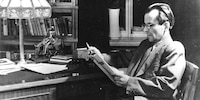
Background information
Sergey Lebedev and the first Soviet computer
by Kevin Hofer
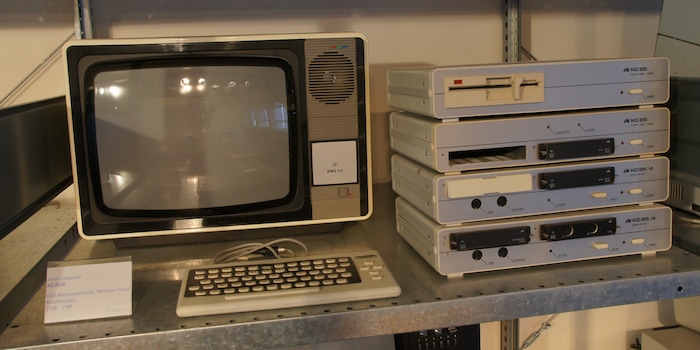
Desktop computers also existed in the German Democratic Republic (GDR). There, they were called Kleincomputer, or small computers, instead of home computers like in Switzerland.
In the 1980s, the first computers are installed in homes in the West. The same is supposed to happen in the GDR. However, the socialist centrally planned economy throws a spanner in the works: production capacities simply aren’t sufficient to equip every home with a computer developed in the GDR. So, most people in the East don’t have their first computer experience at home. The term Kleincomputer, or small computer, instead of Heimcomputer, or home computer, makes sense – barely anyone had one at home.
As early as the 1950s, the GDR leadership pushes electrical engineering and later microelectronics. The 1949 Western CoCom embargo prohibits the import of high technology into socialist countries. That’s why East Germany is dependent on its own developments – or on copies.
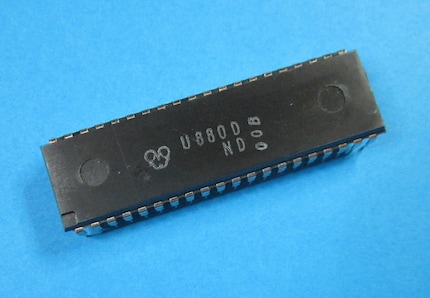
The GDR cribs its first chip from Zilog (article in German). The US manufacturer releases the Z80 in 1976. The 8-bit chip is compatible with the legendary Intel 8080, but more powerful. The first Eastern chip, the U880, is an almost identical, unlicensed copy of the Z80. The U880 is manufactured in the Volkseigener Betrieb (VEB) Mikroelektronik «Karl Marx» from 1980 and is used in almost every small computer until the end of the GDR.
The best-known computers that contain the chip are the KC85, PC1715 and the Z1013 kit. VEB Kombinat Robotron has a hand in all these computers. The Kombinat is responsible for the production of various data processing and computer technology products. Up to 70,000 employees work for Robotron. A large part of the computers produced are exported (article in German).
The Kleincomputer 85 (KC85) is manufactured (article in German) in Mühlhausen from 1984 to 1990. It undergoes several updates. It originally appeared as the HC 900, followed by the KC85/2 (1985), KC85/3 (1987) and KC85/4 (1988). The unit has a remote keyboard, full-colour graphics with 320 × 256 pixels, 16 foreground and eight background colours, and a cassette interface. A television serves as the screen. To find data on the magnetic tape cartridges, you need to rewind. One model costs around 4,000 East German marks – about four months’ income.
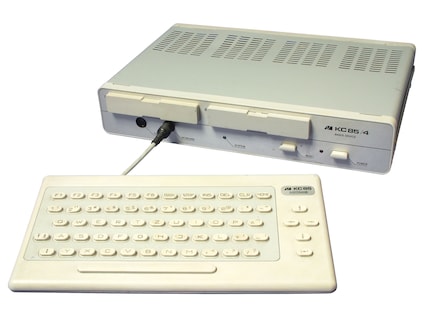
The calculator is mainly used in industry, military and vocational training. Many young people encounter the KC85 at school. But first the GDR kids have to swot up on theory. Only then can they use the computers. Contemporary witness Andre Weissflog recalls the following in his book «Auferstanden aus Platinen» (Risen from circuit boards):
So before we could even get to the computer, we spent ten months studying theory and programming BASIC and all that kind of stuff. That’s when the first games started to be programmed, just as side projects.
Weissflog goes on to say that sharing programs – especially games – was a given. Games are stored on cassettes and sent by mail.
Even today there are people fascinated by this computer. The KC Club regularly publishes an information bulletin and organises meetings.
The PC1715 is something like the standard computer (page in German) of the GDR. With an initial price of over 19,000 East German marks, it cost considerably more than the KC85. From 1985 to 1989, more than 93,000 units are manufactured at the Sömmerda office machine plant. In truth, the plant is meant to focus on printer production. However, those responsible want to focus on the up-and-coming PC product group. Thanks to contacts with the Soviet Union and the pretext of developing a booking machine for them, the PC 1715 is born.
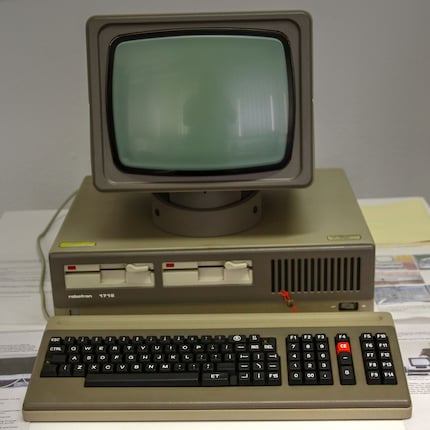
The computer is available in brown and white. It has to manage without a hard disk, but has two floppy drives. The floppy disks store up to 800 kilobytes. There are three keyboard models for the PC1715, which only differ in the shape of the keys.
The PC1715 is mainly used for office work. In the Buna polyclinic (page in German), for example. Here, the first thoughts on electronic data processing (EDP) begin as early as 1985. Extensive preparations resulting in an investment application with proof of profitability are necessary. The first PC1715 is approved in 1986. The same applies to companies in the GDR as to private individuals. If you want something, you have to be patient.
There are an estimated 50,000 PC workstations in the GDR at the turn of the century. It isn’t known how many PCs are privately owned. There are probably only a few PC1715 and KC85 models due to their prices. So, VEB Robotron develops the Z1013.
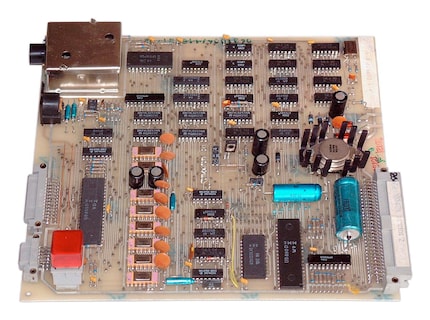
The small computer is a kit without a case. It costs 650 East German marks and must be ordered in advance in writing. You have to pick it up personally from the Robotron specialist store in Erfurt. From 1985 to 1990, about 25,000 kits are produced.
GDR citizen Jens Müller gets hold of one of these kits. On it he learns the programming languages Assembler and Basic (article in German). He also does his homework for his computer science class on the computer. Many of his fellow students have to line up for some computer time in the computer lab. After the fall of the Wall, his Z1013 nevertheless falls into oblivion. Western computers simply do more.
Müller rediscovers his Z1013 in 2001 and his old love rekindles. He develops software that mimics the old computer system. The small computer enthusiast makes JKCEMU available on his home page. The emulator today mimics almost all small computers from the GDR.
But it isn’t only on emulators that GDR computers live on. In fact, fans of the old devices continue to use them. These old computers seem to be built for eternity.
Header image: Wikipedia
From big data to big brother, Cyborgs to Sci-Fi. All aspects of technology and society fascinate me.
Interesting facts about products, behind-the-scenes looks at manufacturers and deep-dives on interesting people.
Show all